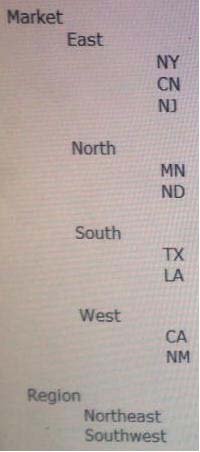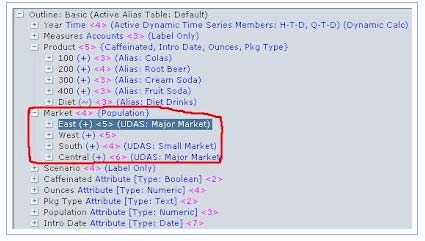Oracle 1z0-531 Exam Practice Questions (P. 5)
- Full Access (69 questions)
- One Year of Premium Access
- Access to one million comments
- Seamless ChatGPT Integration
- Ability to download PDF files
- Anki Flashcard files for revision
- No Captcha & No AdSense
- Advanced Exam Configuration
Question #21
You need to tune a block storage option database for calculations on a 32bit Essbase server. Identify the two starting point tuning steps that you might take
(assuming no direct I/O).
(assuming no direct I/O).
- ASet Index Cache the size of the index file
- BSet Data Cache to the size of 0.125 * pag file
- CSet Data File Cache to the size of .025 * data file
- DReset sparse and dense dimensions to achieve a block size greater than 100KB
Correct Answer:
AB
Here are the best practices to tune a BSO database:
- ACR (Average clustering Rate) should be as close to 1 as possible, launch a dense restructure to de-fragment the database
- Block Size should be between 10 and 100KB (can be more on 64 bit systems)
- Data cache should be 12.5% of the pag files (B)
- Index cache should be the same size as the ind files (A)
- 1 Database per Application
AB
Here are the best practices to tune a BSO database:
- ACR (Average clustering Rate) should be as close to 1 as possible, launch a dense restructure to de-fragment the database
- Block Size should be between 10 and 100KB (can be more on 64 bit systems)
- Data cache should be 12.5% of the pag files (B)
- Index cache should be the same size as the ind files (A)
- 1 Database per Application
send
light_mode
delete
Question #22
The following two members would be optimally tagged Label Only.
- A"Profit"
- B"Rations"
- C"Scenario"
- D"Q1"
- E"January"
Correct Answer:
BC
Label only is a tag that you can apply to a member to indicate that :
* you don't want to store data.
* the Members do not have data associated with them.
Use Label Only for member like Scenarios, Ratios, or Drivers, members whose sole purpose in life is to organize the dimension and hierarchy.
Note:
Although a label only member has no data associated with it, it can display a value. The label only tag groups members and eases navigation and reporting.
Typically, label only members are not calculated.
For example, in the Measures dimension, the member Ratios has three children, Margin%, Profit%, and Profit per Ounce. The member Ratios defines a category of members. When consolidated, Margin%, Profit%, and Profit per Ounce do not roll up to a meaningful figure for Ratios. Hence, Ratios is tagged as label only.
BC
Label only is a tag that you can apply to a member to indicate that :
* you don't want to store data.
* the Members do not have data associated with them.
Use Label Only for member like Scenarios, Ratios, or Drivers, members whose sole purpose in life is to organize the dimension and hierarchy.
Note:
Although a label only member has no data associated with it, it can display a value. The label only tag groups members and eases navigation and reporting.
Typically, label only members are not calculated.
For example, in the Measures dimension, the member Ratios has three children, Margin%, Profit%, and Profit per Ounce. The member Ratios defines a category of members. When consolidated, Margin%, Profit%, and Profit per Ounce do not roll up to a meaningful figure for Ratios. Hence, Ratios is tagged as label only.
send
light_mode
delete
Question #23
Your current block storage option design includes two dimensions: Markets and Regions. The Market dimension looks like:

Users need to be able to report by both regions and markets. Subtotals for Northeast and Southwest will display on some reports.

Users need to be able to report by both regions and markets. Subtotals for Northeast and Southwest will display on some reports.
- AAdd another level to the market dimension for Northeast with North and East as children and Southwest with West and South as children
- BAdd an alternate hierarchy to the market dimension with the states as shared members, rolling up to Northeast and Southwest
- CCreate a UDA with members Northeast and Southwest (associated to states in the Market dimension)
- DCreate an attribute dimension with members Northeast and Southwest (associated to states in the Market dimension)
- ECreate a Text list with the values containing the members Northeast and Southwest.
Correct Answer:
C
Essbase supports this concept called UDAs wherein one can assign the same attribute to multiple dimension members so that one can do cross dimensional attribute analysis. For example, if you take the default Sample-> Basic database you would notice that the Market Dimension members would have some UDAs assigned to it like Major Market, Small Market etc.

Note: user-defined attributes (UDAs).
C
Essbase supports this concept called UDAs wherein one can assign the same attribute to multiple dimension members so that one can do cross dimensional attribute analysis. For example, if you take the default Sample-> Basic database you would notice that the Market Dimension members would have some UDAs assigned to it like Major Market, Small Market etc.

Note: user-defined attributes (UDAs).
send
light_mode
delete
Question #24
Given the following, what is the block size In bytes?


- ABlock size = 40 * 17 * 2
- BBlock size = 40 *17 * 2 * 8
- CBlock size = 50 * 17 * 5
- DBlock size = 50* 17*5 * 8
Correct Answer:
B
We need to multiple the stored (not the total) members of the dense dimensions (here Measures: 40, Time:17, and Dense:2) with 8 to calculate the block size.
Note: Data block size is determined by the amount of data in particular combination of dense dimensions. For ex: when you change the dense or sparse configuration of one or more dimensions in the database, the data block size changes. Data block size is 8n bytes, where n is the number of cells that exist (ie.
Stored, not total) for that combination of dense dimensions.Note: Optimal range is 8 to 100 kb
B
We need to multiple the stored (not the total) members of the dense dimensions (here Measures: 40, Time:17, and Dense:2) with 8 to calculate the block size.
Note: Data block size is determined by the amount of data in particular combination of dense dimensions. For ex: when you change the dense or sparse configuration of one or more dimensions in the database, the data block size changes. Data block size is 8n bytes, where n is the number of cells that exist (ie.
Stored, not total) for that combination of dense dimensions.Note: Optimal range is 8 to 100 kb
send
light_mode
delete
Question #25
Which two statements are true (assuming data is loaded to a BSO database and to the members noted below)?
- AIf you delete a sparse shared member, the outline file shrinks.
- BIf you delete a sparse shared member, the page file shrinks.
- CIf you delete a sparse stored member, the index file shrinks.
- DIf you delete a sparse stored member, the block density shrinks.
- EIf you delete a dense shared member, the block size shrinks.
- FIf you delete a dense stored member, the number of blocks shrinks
Correct Answer:
AC
C: If a member of a sparse dimension is moved, deleted, or added, Essbase restructures the index and creates new index files. Restructuring the index is relatively fast; the time required depends on the index size.
Sparse restructures are typically fast, but depend on the size of the index file(s). Sparse restructures are faster than dense restructures.
AC
C: If a member of a sparse dimension is moved, deleted, or added, Essbase restructures the index and creates new index files. Restructuring the index is relatively fast; the time required depends on the index size.
Sparse restructures are typically fast, but depend on the size of the index file(s). Sparse restructures are faster than dense restructures.
send
light_mode
delete
All Pages
